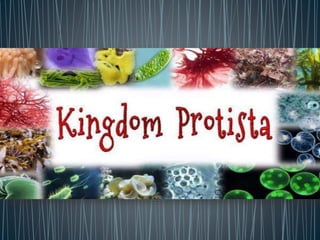Kingdom Protista
•Télécharger en tant que PPTX, PDF•
4 j'aime•390 vues
This is all about Kingdom Protista
Signaler
Partager
Signaler
Partager

Recommandé
Contenu connexe
Tendances
Tendances (20)
Similaire à Kingdom Protista
Similaire à Kingdom Protista (20)
Dernier
Making communications land - Are they received and understood as intended? webinar
Thursday 2 May 2024
A joint webinar created by the APM Enabling Change and APM People Interest Networks, this is the third of our three part series on Making Communications Land.
presented by
Ian Cribbes, Director, IMC&T Ltd
@cribbesheet
The link to the write up page and resources of this webinar:
https://www.apm.org.uk/news/making-communications-land-are-they-received-and-understood-as-intended-webinar/
Content description:
How do we ensure that what we have communicated was received and understood as we intended and how do we course correct if it has not.Making communications land - Are they received and understood as intended? we...

Making communications land - Are they received and understood as intended? we...Association for Project Management
Dernier (20)
Unit-V; Pricing (Pharma Marketing Management).pptx

Unit-V; Pricing (Pharma Marketing Management).pptx
On National Teacher Day, meet the 2024-25 Kenan Fellows

On National Teacher Day, meet the 2024-25 Kenan Fellows
Making communications land - Are they received and understood as intended? we...

Making communications land - Are they received and understood as intended? we...
ICT role in 21st century education and it's challenges.

ICT role in 21st century education and it's challenges.
Vishram Singh - Textbook of Anatomy Upper Limb and Thorax.. Volume 1 (1).pdf

Vishram Singh - Textbook of Anatomy Upper Limb and Thorax.. Volume 1 (1).pdf
This PowerPoint helps students to consider the concept of infinity.

This PowerPoint helps students to consider the concept of infinity.
Fostering Friendships - Enhancing Social Bonds in the Classroom

Fostering Friendships - Enhancing Social Bonds in the Classroom
Kingdom Protista
- 2. • Kingdom Protista is a diverse group of eukaryotic organisms. Protists are unicellular, some are colonial or multicellular, they do not have specialized tissue organization. The simple cellular organization distinguishes the protists from other eukaryotes. Some have flagella or cilia for locomotion. Reproduction in protists is both asexual and sexual. They live in any environment that contains water.
- 3. Protozoans - animal-like single-celled organisms. Algae - plant-like single or multi-celled organisms.
- 4. • Protists that have resemblance to animals are known as protozoans. They in moist and watery environments. The characteristics similar to animals are - their ability to move and their inability to produce their own food (heterotrophs). They differ from animals being unicellular while animals are multicellular.
- 5. • Sacordinians - move using pseudopod. • Zooflagellates - move using flagella. • Ciliaphorans - move using cilia. • Sporozoans - forms spores.
- 6. • The movement in sarcodinians is by extending lobes of cytoplasm known as pseudopodia. The pseudopodia is used for movement and feeding. During the formation of the pseudopodia the cytoplasm streams into the lobe causing the lobe to 'ooze' and grow. Because of this the pseudopodians have a 'blob like appearance.
- 8. • These protozoans move with the help of flagella. Most of them are parasitic. Many flagellates are seen in the intestine of humans, in termites and other animals, some flagellates are harmful.
- 10. • Protozoans of this phylum move with hair like structures called cilia. The movement of cilia is paddle like, it sways back and forth for movement and fast beating of the cilia causes movement of the organism. The cilia is also used to sweep food particles into the organism.
- 12. • All members of this phylum are non-motile and parasitic. They forms spores and hence the name sporozoa. They lack locomotory structures and they are carried in their hosts by their body fluids. Many sporozoans causes serious diseases in humans.
- 14. • Plant-like protists have chlorophyll like that in plants. The green substance in their cells enable them to make food by photosynthesis. The plant-like protists are the major food source and primary producers for water organisms.
- 15. • The green algae include unicellular and multicellular algae. Body is sheet-like thallus. They have cell walls made of cellulose and pectin.
- 17. • Red algae are mostly large and multicellular. They grow in oceans. The algae 'Nori' and Gelidium are used as food, in parts of Asia. Carragean and agar are glue-like substances in red-algae.
- 19. • Brown algae are multicellular. They grow on rocks in shallow water of the sea. Large brown algae are called kelps. The brown algae growing on rocks are known as rockweed.
- 21. • 'Chryso' means 'color of gold'. There are three types of golden-algae: yellow-green algae, golden brown algae, diatoms. • Diatoms are the most abundant and are found in seawater and freshwater habitats. The shell of diatoms are made of silica.
- 23. • It contains of species of one-celled algae called dinoflagellate which means 'spinning swimmers'. They store food in the form of starch and oils. Almost all species like in marine water.
- 25. • Slime Molds - Slime molds are saprophytic protists. They are very bright in appearance. They live in moist soil, decaying plants and trees. They are single- celled organisms.
- 27. • The slime molds are important to ecosystems because they are decomposers, which release vital nutrients back into the environment. • Protists serve numerous purposes in the ecosystem including producing between 70 and 80 percent of the world’s oxygen, being a main food source for aquatic animals and a major decomposing agent of dead material.
- 28. GROUP 3 Christine Joy Legaspi Ariel Vergara Mark Paul Carnate David Resan Navalta Krystel Mae